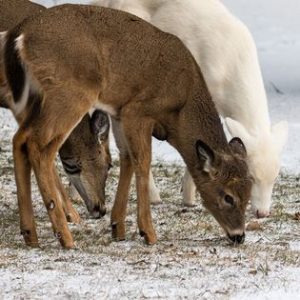
Marquette: Michigan’s “Boulder Junction”

These deer are crowded around to hear the rest of the story. “Was that really my great, great, great grandfather?” Photo by Steve Lindberg.
White and albino deer are extremely rare, but pockets do occur. Wisconsin has it’s Boulder Junction, Minnesota has Father Hennepin State Park, and Michigan has Marquette.
Marquette is known as a university town and Great Lakes shipping port on the south shore of Lake Superior. One of its lesser known claims to fame is that it is also home to a small population of white deer. What is even more unique is that the deer can actually be traced back to just one animal and one event.
It all started in the winter of 1981-82 when an albino buck began appearing in the Rapid River area about 60 miles southeast of Marquette. The buck could be seen on a regular basis along Hwy 2 east of Rapid River. People enjoyed watching the deer and began feeding him.
Fears began to grow, though, that the animal could be hit by a car or poached, so residents petitioned the DNR to move the animal to a safer location. The DNR kindly obliged and the buck was tranquilized and successfully moved to a deer enclosure at Presque Isle Park, a 323-acre park located on a peninsula right next to the city of Marquette.
After this, however, things didn’t go so well. The white buck kept crashing against the fence trying to get out and some of the resident deer started attacking him. The new buck was an intruder to them and he was not welcome. In all fairness, he didn’t want to be there either.
To protect the white deer and allow the rest of the herd to get used to him, a small pen was built for the buck inside the larger pen. Within several months “Snow,” as he was now called, not only became part of the herd, he became the dominant buck and bred a number of does. Several white fawns were eventually born, but only one survived to adulthood.
Snow was a popular attraction at the little Presque Isle zoo for the next six years, but then tragedy struck. In the fall of 1988 the white buck broke his leg in a fight with another buck and had to be euthanized. He was 7½ years old. This was the end of Snow, but not his genes, which were carried by an unknown number of brown offspring. Snow’s story was not over.
In 1992, to reduce overcrowding in the deer pen, 14 of the captive deer were released into the greater park. One of these deer, a brown doe, gave birth to twin white fawns. As adults, these two white bucks migrated outside the park but remained in the Marquette area where they were often seen and photographed. Unfortunately, despite white deer being legally protected in Michigan at the time, both were killed within two years by poachers.
In 1994, in compliance with new USDA human/captive deer contact guidelines to prevent the spread of disease, the deer pen in Presque Isle Park was taken down. Several white fawns were born in the park in subsequent years, giving visitors a very high chance of seeing one. Many of the deer were quite tame and park visitors enjoyed feeding them.
With no food worries and no predators, the herd numbers on Presque Isle constantly grew. To keep the population in check the park had a “trap and transfer” program. Excess deer were live-trapped and then transported to areas outside the park. None of the white deer, however, were ever moved.
Then, in 2000, two more policies were implemented at Presque Isle that would soon prove disastrous for both the brown and the white deer. The DNR, again as a disease precaution, prohibited feeding deer in the park and they stopped their “trap and transfer” program.
With few options left to control the increasing deer population, the park resorted to a herd cull in early 2001—a decision that was extremely unpopular and resulted in an unsuccessful year-long public battle. No white deer were targeted, but 62 brown deer, many undoubtedly carrying the albino gene, were ultimately killed by sharpshooters.
A severe winter after that and record snowfalls, coupled with the ban on feeding, resulted in the starvation of much of the remaining deer herd, including the herd’s three white deer. The white deer were now gone, but not the white genes—as the birth of occasional white fawns in the following years would indicate.
Now, over 20 years later, the great, great, great offspring of Snow, the original Rapid River white buck, can still be seen in Marquette and at Presque Isle Park. At least six white deer are reported to call Marquette home and several more are occasionally seen outside the city limits.
Unfortunately, Michigan got rid of white deer protection in 2008, so white and albino deer are now fair game throughout the state. Considering the hunting pressure for trophy deer and Marquette’s very harsh winters, it is amazing that the white deer have survived this long.
On the up side, enough people appreciate the white deer to give them a little survival edge and the recessive white genes manage to persist. As Jeff Goldblum’s character, Dr. Ian Malcolm, states in the movie Jurassic Park: Life, uh…finds a way.

Two present day residents at Presque Isle Park: a white mom and her nearly-grown brown fawn. Photo by Steve Lindberg.
Article notes: The information for this article was gleaned from several sources, but predominantly from an article titled Marquette’s Albino Deer by Michigan outdoor writer Richard Smith.
A surreal experience. Marquette resident Kelly Kivi-Westlund comments on Pinterest: “Nearly every year there’s at least one new albino fawn near Marquette, Michigan. Seeing one is as surreal as seeing a ghost walk through your yard.” And here is a video of one that took a walk with her family right down a Marquette street.
A childhood remembrance. Dawn Adamson remembers visiting Presque Isle Park with her dad on a cold winter day: When the Albino Deer Came to Stay at Presque Isle Park.
A lot of snow. A note on Lake Superior snowfall: another one of Marquette’s distinctions is being one of the snowiest cities east of the Rockies. Marquette’s total snowfall in 2000-01 was 268 inches. In 2001-02 it was a record 319.8 inches. That’s over 26 ft. of snow! No wonder so many deer, all over the Upper Peninsula, died of starvation those two winters.


